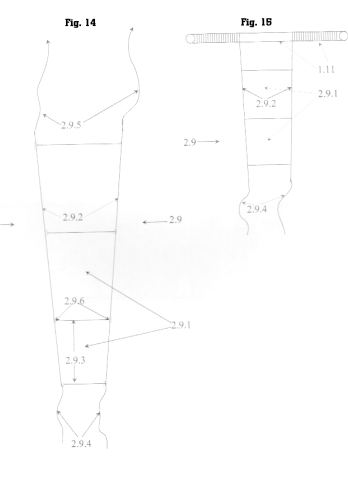
The Earth weight of such a panel for the authors reference design of about 1111 m, about 4 m width on the long end and about 6 cm width on the small end would be aproximateley between 2.5 kg and 6 kg depending on the thickness of the foil (here between 1.1 to 2.2 micron).
The unfurl winches are pulling the sail toward the sailcraft center with the threads 2.9.4.. To handle the at maximum 6 kg Earth mass of the sail panels under micro gravitation conditions the electric motors for the pulling winches and roll brackets donīt have to develop much force and can be made very lightweight.
Fig. 15 shows a sail panel partly on the roll. The edge-threads 2.9.4 are protecting the sail foil when lying on it. I am pretty sure that such a setup will enable us to get even thinner sail material into space without harming it. To get such a roll into itīs brackets on the Outer Ring is easy compared with folding, launching, unfolding a big folded sail and placing and connecting it to the sail structure.
It will be also easy to repair such a single panel. Just get the panel roll out of their brackets and put another one back.
For a 2260-m diameter sail design with a 30-m docking and payload station the length of one panel would be about 1111 m. Given a foil thnickness of 2.1125 micron (two micron substrat plus two sides aluminum coating) a roll of 6 cm diameter would have a diameter of 6 cm on the sides and of about 8 cm in the middle. With a substrat thickness of 1 micron the middle diameter would only be about 7cm.